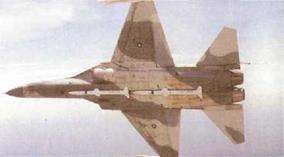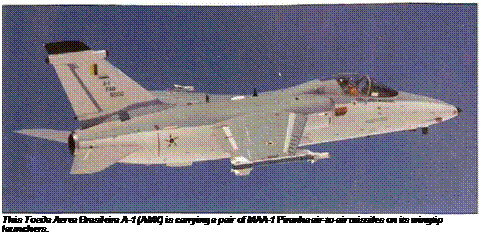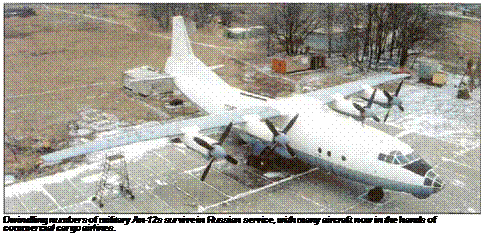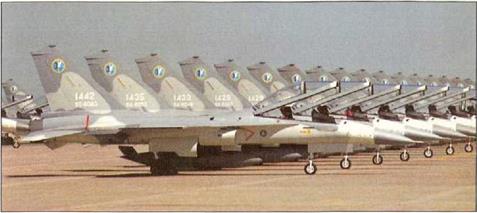AIDC F-CK-1 Ching-Kuo
|
 |
 |
|
T |
aiwan’s ambitious programme to develop the advanced Indigenous Defence Fighter (IDF) to replace its fleet of F-bs and F-104s began in 1982 after a US arms embargo was imposed to appease mainland China. However, no restrictions were placed on technical assistance, and US companies collaborated closeiy’with AIDC to develop the new airframe (General Dynamics), radar (Westinghouse). engine (Garrett) and other systems.
The resulting Ching Kuo fighter (named in honour of a Taiwanese president, in 1988) is of conventional all-metal construction and configuration, bearing a passing resemblance to an F-16/F-18 hybrid with wing/fuselage blending. Elliptical intakes are located below :ong leading-edge root extensions (LERXes). The pressurised cockpit is fitted with a sidestick controller (like the F-16), a wide-angle HUD and two multi-function displays. The GD-53 Golden Dragon multi-mode radar is derived from Lockheed Martin’s AN/APG-67V, wrth elements of the Northrop Grumman (formerly Westinghouse) AN/APG 66 also. Power is supplied by two ITEC TFE1042-70 turbofans, licence-built versions of the Garret (AlliedSignal) F125.
The first of three single-seat prototypes made its maiden flight on 28 May 1989, followed by the first two-seat prototype in July 1990. The first of 10 pre – production aircraft was rolled out on 9 March 1992 and-introduced new enlarged engine intakes and a small ventral fin, following the loss ox one of the
prototypes in development flying. Deliveries to the Republic of China Air Force began nearly one year earlier than scheduled with the public unveiling of the first squadron in February 1993.
Several indigenously-developed weapons have been fielded for the Ching Kuo, including the Tien Chien (sky sword] 1 IR dogfight missile, and the Tien Chien 2 medium-range air-to-air missile. The Ching Kuo can also carry the Hsiung Feng 2 (male bee) anti-ship missile.
The single-seat version of the Ching Kuo has received the ROCAF designation Е-СКЙд, while the F-CK-1 В is the combat-capable two-seater. Due to the cost of the project (and the renewed availability of F-16s to Taiwan), the ROCAF requirement for 250 aircraft was cut back to 130 – of which 28 were F-CK-1 Bs. The last two Ching Kuos were handed over in January 2000 and Taiwan currently has six squadrons (two wings) equipped with the type. AIDC is now working on a simplified version of the Ching Kuo as a lead-in fighter trainer for export. A prototype is expected to fiy in 2002.
The Ching Kuo carries the indigenously-developed Sky Sword / IR-guided short-rangeAAMs and Sky Sword II radar-guided medium range AAMs.
 |
Development of the AMX started in April 1978 when Aeritalia (now Alenia) and Aermacchi combined their resources to meet an Italian air force (AMI) requirement for a multi-purpose strike/reconnaisssnce aircraft. The programme rece ved extra impetus in 1980 when Brazil’s EMBRAER joined the two Italian companies. A common specification called for good short-field performance, high subsonic operating speeds end advanced nav/attack systems for low-level day/night missions in poor visibility. This resulted in a conventional aircraft with a relatively compact airframe and moderately-swept high-mounted wings, and powered by a single Rolls-Royce Spey turbofan. Seven single-seat prototypes were built and the first of these made its maiden flight on 15 May 1984. Design work on a two-seat version, the AMX-Т, began in 1986. The first AMX production batch included 21 aircraft for Italy and nine for Brazil The first production-standard AMX was rolled out at Turin on 29 March 1988, and flew on 11 May.
In 1988 a second production contract for 84 AMXs was placed, following on from the initial batch of 30. This second order comprised 59 for Italy (including six AMX-Ts) and 25 for Brazil (with three AMX-Ts). The first deliveries to the Italian air
The upgraded and modernised AMX-ATA is based on the two-seat AMX-T airframe, hut adds a new radar, avionics and digital cockpit systems.
force took olace in April 1989, while Brazil too* delivery of ;ts firs: aircraft in Octooer 1989. In Brazilian service the AMX is known as the A-1. The first of three AMX-T trainer prototypes flew on 14 March 1990. The first production-standard AMX-T was delivered to Brazil in May 1992, while the first Italian aircraft was handed over in 1994, In Brazilian service the AMX-T is designated TA-1.
Italy has acquired a total of 136 aircraft (110 AMXs, 26 AMX-Ts) and the fina! delivery was made in 1997. Brazil has ordered a total of 79 aircraft (65 A-1s, 14 TA-1s) and deliveries from EMBRAER are almost complete. The main difference between the Brazilian A-1 and Italian AMXs is that the former are armed with two 30-mm cannon, in place of the latter’s single 20-mm gu;n. Some of the single-seat A-1s have been converted to RA-1 reconnaissance aircraft
 |
 |
In September 1999 Venezuela ordered 24 improved AMX-ATA (Advanced Trainer and Attack! aircraft, which will have a new digital cockpit, new radar and avionics derived from the EMBRAER ALX programme. Both Italy and Brazil are now looking at applying similar upgrades to their existing aircraft – particularly in the light of the AMX’s impressive combat debut during Operation Allied Force.
 |
Designed by the Ukrainian-based Antonov Bureau, the four-engined Antonov An-12 (allocated the NATO code-name ‘Cub’), was the standard military atrlifter of the Soviet Union and its allies from the early 1960s onwards. Roughly equivalent to the C-130 Hercules, the An-12 was a high-wing, rear-loading freighter, which was also adapted to a wide range of other specialist roles. Unlike the Hercules many versions were armed with a rear gun turret at the base of the fin. The prototype An-12 made its maiden flight on 16 December 1957. Approximately 1,265 aircraft were built at factories in Irkutsk, Tashkent and Voronezh by the early 1970s.
The first major production variant was the An-12A (1961) which had more fuel and more powerful engines than the An-12. In 1963 this was replaced by the An-12B (1963), now fitted with an independent APU. Aircraft with extra underfloor fuel tanks were designated An-12APs or An-l2BPs. A wealth of special missions conversions began to appear during early 1970s. These included the An-12PS ‘Cub-B’ Elint aircraft, the An-12B-VKP Zebra airborne commend post and the An-12RKR NBC reconnaissance aircraft.
The definitive transport version, the An-12BK. appeared in 1967 to replace the An-126. These aircraft were exported to a number of friendly air forces, including India which used its An-12BKs as makeshift bombers during the war with Pakistan in 1971 The An-12PP ‘Cub-C’ was another specialised EW variant, with a large extended tailcone and a
comprehensive jamming fit. The simiiar-loo<inc An-12BK-PPS ‘Cub-D’ was another airborne janmerj this time fitted with a number of large scabbed-on Sirena jamming pods. Other An-12s are modified for tasks such as weather research (An-12BKTs Tsyklon) and ejection-seat development (An-12LL)
The An-12 was exported to 14 countries; Algeria. Bulgaria, China, Cuba, Czechoslovakia, Egypt, Ghana, Guinea, India, Indonesia, Iraq, Poland, Yemen and Yugoslavia. Many of fhese aircraft have now been retired, but a few hundred are still in service The An-12 is alive and well in China, were it is built as the Shaanxi Y-8 (based on the An-12BK airframe). The Y-8 is an unlicensed copy of the An-12. It is currently in production, with a range of new var ants still under development. The first Y-8 flew on 25 December 1975 and somewhere between 70 and 100 nave been built. This includes the improved Y-8A military transport, the civil Y-8B, the pressurised Y-8C freighter, the export Y-8D with Western-supplied avionics, the Y-8E drone-launching platform, Y-8F livestock carrier and Y-8X maritime-patrol aircraft.
 Specification: Antonov Ait-12BP Cub-A’ Powerplant: lour 2983-kW(4.000-hp)ZMOB Progress (Ivchenko) AI-20K turboprops Dimensions: span 38.00 m (:24 ft 8 in), ienoth 33.10 m (108 ft 7.25 fn); height 10.53 m (34tt5.5 in!
Specification: Antonov Ait-12BP Cub-A’ Powerplant: lour 2983-kW(4.000-hp)ZMOB Progress (Ivchenko) AI-20K turboprops Dimensions: span 38.00 m (:24 ft 8 in), ienoth 33.10 m (108 ft 7.25 fn); height 10.53 m (34tt5.5 in!
Weights: empty 28000 kg (G.728 lb): maximum take-off 61000 kg 1134,480 lb); maximum payload 20000 kg (44,092 lb) Performance: maximum level speed 777 kmh (482 mph); maximum rata of climb at sea level 600 m (1,969 ft) per minute: service ceiling 10200 m (33,465 ft); range 5700 km (3,542 miles) with maximum fuel or 3600 km (2.237 miles) with maximum payload
Ukraine (China)












